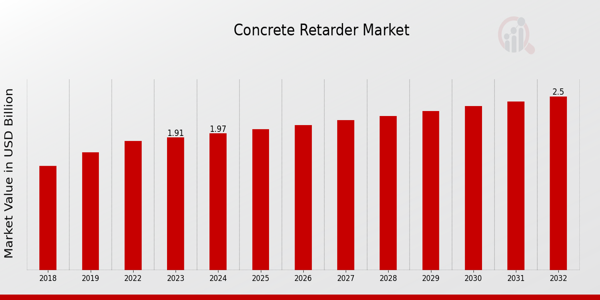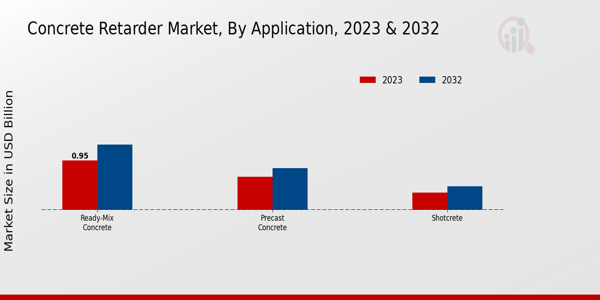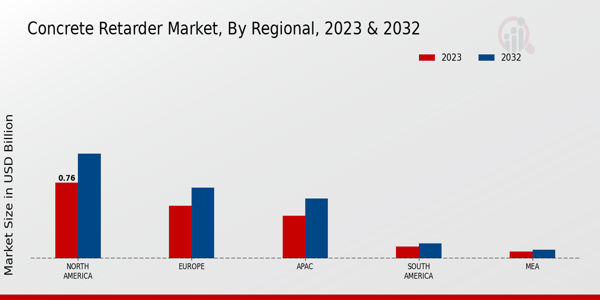Global Concrete Retarder Market Overview
Concrete Retarder Market Size was estimated at 2.03(USD Billion) in 2024. The Concrete Retarder Market Industry is expected to grow from 2.09(USD Billion) in 2025 to 2.74(USD Billion) by 2034. The Concrete Retarder Market CAGR (growth rate) is expected to be around 3.00% during the forecast period (2025 - 2034).

Source Primary Research, Secondary Research, MRFR Database and Analyst Review
Key Concrete Retarder Market Trends Highlighted
The concrete retarder market is witnessing significant growth driven by the rising demand for high-performance concrete in construction projects. This demand is largely influenced by the increasing investment in infrastructure development, urbanization, and a growing focus on sustainable building practices. Concrete retarders play a critical role in managing the setting time of concrete, which is essential for optimizing construction efficiency and improving the quality of the final product. With the ongoing expansion of the construction industry, particularly in developing economies, the need for concrete additives such as retarders is expected to rise steadily.Opportunities in the concrete retarder market are abundant as industries seek innovative solutions to enhance construction processes. Key areas for exploration include the development of environmentally friendly retarders that minimize the ecological footprint associated with traditional chemical additives. Additionally, advances in technology and the rise of smart construction solutions provide a platform for incorporating new types of retarders that cater to specific project requirements. The increasing popularity of ready-mixed concrete also presents opportunities for manufacturers to diversify their product offerings and cater to a broader customer base.In recent times, there has been a noticeable shift toward the use of bio-based or natural retarders, fueled by the growing environmental awareness among consumers and regulators alike. This trend indicates a transformation in the market landscape, where eco-friendly products are gaining acceptance alongside traditional chemical options. Moreover, the emergence of digitally integrated construction processes is influencing the demand for retarders tailored for high-tech applications. As the focus continues to shift toward sustainability, the concrete retarder market stands at a pivotal moment, encouraging innovation and adaptation to meet evolving industry needs.
Concrete Retarder Market Drivers
Increasing Demand for Construction Activities
The Concrete Retarder Market Industry is experiencing significant growth largely due to the increasing demand for construction activities across various sectors. As urbanization continues to accelerate globally, the need for infrastructure development, commercial buildings, and residential projects is on the rise. This heightened demand for construction requires effective management of concrete setting times, which is where concrete retarders come into play.These chemical additives are essential in managing the working time of concrete, particularly in high-temperature conditions where quick setting could inhibit proper placement and finishing. The concrete retarder industry is benefiting from various large-scale construction projects, including highways, bridges, and high-rise buildings. The ongoing investments by governments in infrastructure projects further amplify this demand, presenting a robust growth opportunity for the Concrete Retarder Market.Innovations and advancements in construction technologies are leading to new applications for retarders, thus driving their necessity in the concrete formulation process. Furthermore, the increasing number of mega construction projects, especially in emerging economies, stimulates the demand for concrete retarders, thereby enhancing the growth potential of the market.
Technological Advances in Concrete Retarders
The Concrete Retarder Market Industry is propelled by continuous innovations and technological advancements in the formulation and application of concrete retarders. Manufacturers are focusing on developing high-performance retarding agents that provide better control over the setting time of concrete. These advancements not only improve the effectiveness of the retarders but also their compatibility with different types of cement and other concrete admixtures.The growing emphasis on sustainable construction practices has led to the creation of eco-friendly and non-toxic retarders, further expanding the market. As construction technologies evolve, the need for advanced solutions that enhance concrete performance while optimizing workability is becoming paramount, pushing the demand for innovative concrete retarding solutions.
Growth of the Infrastructure Sector
The ongoing growth of the infrastructure sector globally is another significant driver for the Concrete Retarder Market Industry. With governments and private enterprises investing heavily in infrastructure projects such as roads, bridges, and public transport systems, the demand for concrete is expected to rise sharply. Concrete retarders play a critical role in large infrastructure projects, particularly in managing the complexities associated with long haul times and the transportation of concrete to various sites.As urban areas continue to expand and develop, the need for reliable and effective construction materials continues to increase. This surge in infrastructural development not only supports the concrete retarder market but also encourages collaboration among stakeholders to ensure the necessary performance and quality of concrete is achieved.
Concrete Retarder Market Segment Insights
Concrete Retarder Market Application Insights
The Concrete Retarder Market is experiencing a steady increase in its valuation, currently estimated at 1.91 USD Billion in 2023, and expected to grow significantly by 2032, reaching 2.5 USD Billion. Analyzing the market segmentation within the Application segment reveals distinct areas of focus Ready-Mix Concrete, Precast Concrete, and Shotcrete. Among these, the Ready-Mix Concrete application stands out as a prominent contributor, initially valued at 0.95 USD Billion in 2023 and predicted to rise to 1.25 USD Billion by 2032. This growth can be attributed to the increasing demand for construction activities and the convenience offered by ready-to-use concrete solutions, highlighting its majority holding in the overall Concrete Retarder market.Precast Concrete, valued at 0.63 USD Billion in 2023 and expected to reach 0.8 USD Billion by 2032, also plays a significant role, primarily due to its application in modular construction projects and industrial buildings, enhancing efficiency and reducing lead times, hence facilitating its status as a critical factor in market growth. Meanwhile, the Shotcrete application, holding a value of 0.33 USD Billion in 2023 and projected to grow to 0.45 USD Billion by 2032 while showing a slower growth trajectory, remains essential for sectors like tunneling and mining, where its properties allow for rapid application and structural support.The diverse applications of concrete retarders across these segments reflect the broader trends in the Concrete Retarder Market industry, where the intersections of modern construction practices, efficiency demands, and material innovation drive the evolution and outlook of the market. As these applications continue to grow, the Concrete Retarder Market data points to a well-defined path of sustained growth, shaped by both industry demands and technological advancements.

Source Primary Research, Secondary Research, MRFR Database and Analyst Review
Concrete Retarder Market Type Insights
The Concrete Retarder Market has shown notable potential, with a market value of 1.91 billion USD in 2023. The segmentation of this market by Type highlights critical categories including Natural Retarder, Chemical Retarder, and Mineral Retarder, each contributing significantly to market dynamics. The Natural Retarder sector is gaining traction due to its environmentally friendly characteristics, appealing to sustainable construction practices. Chemical Retarders, which offer enhanced performance in prolonged setting times, dominate the market by providing flexibility in various weather conditions, making them essential in construction projects.The Mineral Retarder segment plays a vital role as well, especially in providing improved durability and strength to concrete mixtures. These distinct types not only enhance the overall effectiveness of concrete applications but also align with the growing trend toward more resilient and sustainable construction methods. The Concrete Retarder Market data confirms that the demand across these types is driven by increasing construction activities globally, fostering a steady growth trajectory and presenting opportunities for further innovation within the industry.The market growth for this segment aligns with broader trends emphasizing performance and sustainability in construction solutions.
Concrete Retarder Market End-Use Insights
The Concrete Retarder Market is comprehensively segmented by End Use, reflecting diverse applications in various fields. In 2023, the market achieved an approximate valuation of 1.91 billion USD and is on track for growth, with future expectations driving key developments across its segments. The Residential sector plays a vital role, with numerous construction projects that require precise setting time control in concrete to ensure quality and durability. The Commercial sector also presents significant opportunities, as an increase in urbanization and commercial infrastructure contributes to the demand for efficient construction solutions.Meanwhile, the Infrastructure segment continues to lead due to its immense projects, encompassing roads, bridges, and public utilities, requiring robust retarding solutions for large-scale operations. The Industrial sector, focusing on manufacturing facilities, also contributes to the overall demand. This intricate mix of End-use categories showcases the Concrete Retarder Market's diverse applicability and resilience in meeting the evolving needs of construction, driven by growth initiatives and sustained development. As such, understanding the Concrete Retarder Market revenue trends and statistics within these segments becomes crucial for stakeholders aiming to capitalize on emerging opportunities and navigate challenges effectively.
Concrete Retarder Market Formulation Insights
The Concrete Retarder Market, with a projected revenue of 1.91 billion USD in 2023, shows a robust landscape, particularly in the Formulation segment, where it plays a pivotal role in enhancing the properties of concrete. This segment comprises various types, including Liquid, Powder, and Granular formulations, catering to different application needs within the construction industry. Liquid formulations dominate the market due to their easy application and effectiveness in high-temperature conditions, which makes them essential for large-scale construction projects.Powder formulations are also significant, as they offer longer shelf life and ease of transport, while Granular formulations are increasingly recognized for their stability and consistency in performance. The Concrete Retarder Market statistics indicate strong growth drivers, such as urbanization and infrastructure development, which fuel the demand for concrete retarders. However, challenges like fluctuating raw material prices might impact market growth. Opportunities abound, particularly in developing countries where construction activities are surging, making this segment vital for meeting industry demands and enhancing concrete performance.
Concrete Retarder Market Regional Insights
The Concrete Retarder Market revenue demonstrates a steady growth trajectory across various regions, signifying increasing demand for specialized concrete solutions. In 2023, North America led the market with a significant valuation of 0.76 USD Billion, projected to rise to 1.05 USD Billion by 2032, showcasing its major position due to robust construction activities. Europe follows with a valuation of 0.53 USD Billion in 2023 and is expected to enhance to 0.71 USD Billion, emphasizing its importance in infrastructure development. The Asia-Pacific (APAC) region, though slightly behind, holds a substantial market share with 0.43 USD Billion in 2023, reflecting the region's growing emphasis on urbanization and construction strategy, leading to a foreseeable increase to 0.6 USD Billion by 2032.South America's market is valued at 0.12 USD Billion currently, which is modest yet indicates potential growth in construction advancements, expecting a slight growth to 0.15 USD Billion. Meanwhile, the Middle East and Africa (MEA) region accounts for 0.07 USD Billion, displaying slower growth, anticipated to reach 0.09 USD Billion, likely due to varying economic factors. These regional insights reveal the Concrete Retarder Market segmentation, highlighting the diverse dynamics influencing market growth and opportunities within each area.

Source Primary Research, Secondary Research, MRFR Database and Analyst Review
Concrete Retarder Market Key Players and Competitive Insights
The Concrete Retarder Market has been witnessing significant growth due to increasing construction activities and infrastructure development across various regions. As companies strive to optimize the setting time of concrete in different weather conditions and to enhance the overall durability and quality of the structures being built, a competitive ecosystem has emerged. The market features a blend of established players and new entrants, each aiming to leverage innovations in technology and product formulations to capture a larger market share. Competitive dynamics are shaped by factors such as product effectiveness, pricing strategies, distribution channels, and customer relationships, alongside the growing demand for high-performance concrete solutions. Players are also engaging in strategic collaborations and mergers to strengthen their market position and expand their geographic footprint, ensuring that they can meet the diverse demands of clients in a rapidly evolving industry landscape.GCP Applied Technologies stands out in the Concrete Retarder Market due to its robust product portfolio and commitment to quality. The company's innovative approach to developing sustainable and effective retarding agents has positioned it well among competitors, as it focuses on providing tailored solutions to meet specific customer needs. GCP Applied Technologies emphasizes research and development, which enables it to stay ahead of trends and address the evolving demands of the market. The company's strategic alliances, extensive distribution networks, and customer-centric approach enhance its market presence and allow it to maintain strong relationships with key stakeholders. Its dedication to enhancing the performance of concrete in various weather conditions further solidifies its reputation as a leader in this sector, enabling GCP Applied Technologies to effectively cater to both regional and markets.MAPEI has established a strong foothold in the Concrete Retarder Market by leveraging its extensive experience and expertise in construction chemicals. The company is recognized for its high-quality concrete retarders that are engineered to improve workability and extend setting times, thereby supporting diverse construction applications. MAPEI prioritizes innovation, continuously investing in research and development to introduce advanced formulations that meet the rigorous standards of the building and construction industry. This forward-thinking philosophy not only strengthens its position in the marketplace but also aligns with the growing demand for sustainable construction practices. MAPEI's reach is supported by a comprehensive network of distribution channels, allowing it to serve a wide array of customers effectively. The company’s commitment to quality, reliability, and customer satisfaction makes it a formidable competitor in the concrete retarder sector, positioning it well to respond to the challenges and opportunities presented by a dynamic market landscape.
Key Companies in The Concrete Retarder Market Include
- GCP Applied Technologies
- MAPEI
- RHEONIK
- Arkema
- Sika
- Aditya Birla Chemicals
- Chryso
- BASF
- Setcrete
- Dow
- Cemex
- Kryton International
- R. Grace
- Huntsman
- Fosroc
Concrete Retarder Market Industry Developments
Recent developments in the Concrete Retarder Market reveal a growing trend toward innovation and expansion among key players. Companies like GCP Applied Technologies, MAPEI, and Sika are actively enhancing their product lines to meet the rising demand for high-performance concrete solutions, which is driving competition and technological advancements. Additionally, BASF and Dow are focusing on sustainability, emphasizing eco-friendly retarding agents that align with environmental regulations. In terms of mergers and acquisitions, Arkema has demonstrated strategic intent to expand its market presence through targeted acquisitions, while Aditya Birla Chemicals has been exploring partnerships to diversify its offerings. Companies such as Chryso and Kryton International are also witnessing growth in market valuation, which positively affects their competitive positioning. The increasing emphasis on infrastructure development and urbanization is further propelling the demand for concrete retarders, with market forecasts suggesting robust growth rates. Overall, the Concrete Retarder Market is poised for significant transformation as leading firms adapt to evolving market conditions and consumer preferences, fostering a landscape ripe for innovation and collaboration.
Concrete Retarder Market Segmentation Insights
Concrete Retarder Market Application Outlook
- Ready-Mix Concrete
- Precast Concrete
- Shotcrete
Concrete Retarder Market Type Outlook
- Natural Retarder
- Chemical Retarder
- Mineral Retarder
Concrete Retarder Market End Use Outlook
- Residential
- Commercial
- Infrastructure
- Industrial
Concrete Retarder Market Formulation Outlook
Concrete Retarder Market Regional Outlook
- North America
- Europe
- South America
- Asia Pacific
- Middle East and Africa
| Report Attribute/Metric |
Details |
| Market Size 2024 |
2.03(USD Billion) |
| Market Size 2025 |
2.09(USD Billion) |
| Market Size 2034 |
2.74(USD Billion) |
| Compound Annual Growth Rate (CAGR) |
3.00% (2025 - 2034) |
| Report Coverage |
Revenue Forecast, Competitive Landscape, Growth Factors, and Trends |
| Base Year |
2024 |
| Market Forecast Period |
2025 - 2034 |
| Historical Data |
2020 - 2024 |
| Market Forecast Units |
USD Billion |
| Key Companies Profiled |
GCP Applied Technologies, MAPEI, RHEONIK, Arkema, Sika, Aditya Birla Chemicals, Chryso, BASF, Setcrete, Dow, Cemex, Kryton International, W.R. Grace, Huntsman, Fosroc |
| Segments Covered |
Application, Type, End Use, Formulation, Regional |
| Key Market Opportunities |
Rising infrastructure development projects, Increasing demand for green construction, Technological advancements in formulations, Expansion in emerging markets, Growing preference for low-dust products |
| Key Market Dynamics |
Increasing construction activities, Demand for high-performance concrete, Stringent regulations on environmental impact, Growing infrastructure development projects, Technological advancements in concrete additives |
| Countries Covered |
North America, Europe, APAC, South America, MEA |
Frequently Asked Questions (FAQ) :
The Concrete Retarder Market is expected to be valued at 2.74 USD Billion in 2034.
The expected CAGR for the Concrete Retarder Market from 2025 to 2034 is 3.00%.
The Ready-Mix Concrete application segment is expected to dominate the Concrete Retarder Market with a value of 1.25 USD Billion in 2032.
The North American region was valued at 0.76 USD Billion for the Concrete Retarder Market in 2023.
The Precast Concrete segment is projected to be valued at 0.8 USD Billion in 2032.
Key players in the Concrete Retarder Market include GCP Applied Technologies, MAPEI, Arkema, and Sika.
The anticipated market size for the Shotcrete application is expected to reach 0.45 USD Billion by 2032.
The Europe region is expected to have a market value of 0.71 USD Billion in 2032.
The entire Concrete Retarder Market was valued at 1.91 USD Billion in 2023.
The South American region is projected to grow to 0.15 USD Billion by 2032.

















